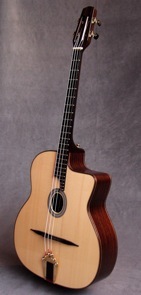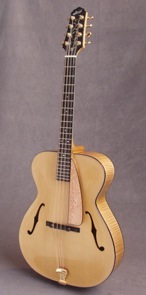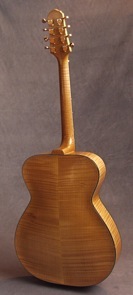OCTAVE MANDOLINS:
The octave mandolin has a guitar shaped body with a 14 - 3/8” lower bout. The top and back are carved from air dried split billets. The top is X-braced Engelmann spruce with F holes. Back and sides are curly Big Leaf maple. The neck is of either one or two piece Red maple with an adjustable truss rod, further reinforced with two pieces of 1/8” X 3/8” graphite rod that extends through the peg head, strengthening that vulnerable area. The adjustable truss rod is accessed from under the finger board extension.
The finger board is ebony and has a scale length of 21 - 1/2” making it short enough to be easy to play, while long enough to support the lower register. Tuners are Gotoh minis in gold or nickel plate. The adjustable bridge is ebony and the tail piece is a gold or silver Monteleone, which accepts either loop or ball end strings. Instruments are fully bound.
Octave mandolins are typically blond finished lacquer with an unbound birds-eye maple pick guard and heel cap. Sunburst finishes are an additional $150. Octave mandolins can either be strung with all four pairs (courses) in unison, or with the bottom two courses (low G and D pairs) tuned in octaves, with the top two courses (A and E pairs) tuned in unison.
The octave mandolin is a rewarding instrument for all styles of music and is especially well suited for accompanying a singer. Custom Cedar Creek case included.
SELMER:
The prototype Selmer style octave mandolin was built for Bryce Milano, a gifted 13 year old mandolinist from Pennsylvania. The design is essentially a scaled down version of the famous Selmer “Petite Bouche” guitar, made famous in the hands of gypsy guitarist, Django Rheinhardt. Bryce, his father Joseph (a talented glass artist, as well as the brains behind this web site) and I tweaked the design for balance and scale, making a concert ready version of the Selmer as a 4 string octave mandolin.
The Selmer Octave has an Engelmann spruce top, east Indian rosewood back and sides, a mahogany neck, and an ebony fingerboard and bridge. It is finished with lacquer. The construction is a hybrid of the Selmer and modern guitar building techniques, the challenge being that the whole package revolve around scale length. After much discussion, we landed on 23 - 1/2 “ for both playability and tonal concerns. We specifically wanted to have a body and scale length of great enough size to support a powerful bottom end (we knew the highs would be there), but most importantly, Bryce wanted an instrument with that “Hot Club” sound. The Selmer octave was so successful that I’ve added it to my permanent lineup. It’s quite something in the hands of Bryce.






